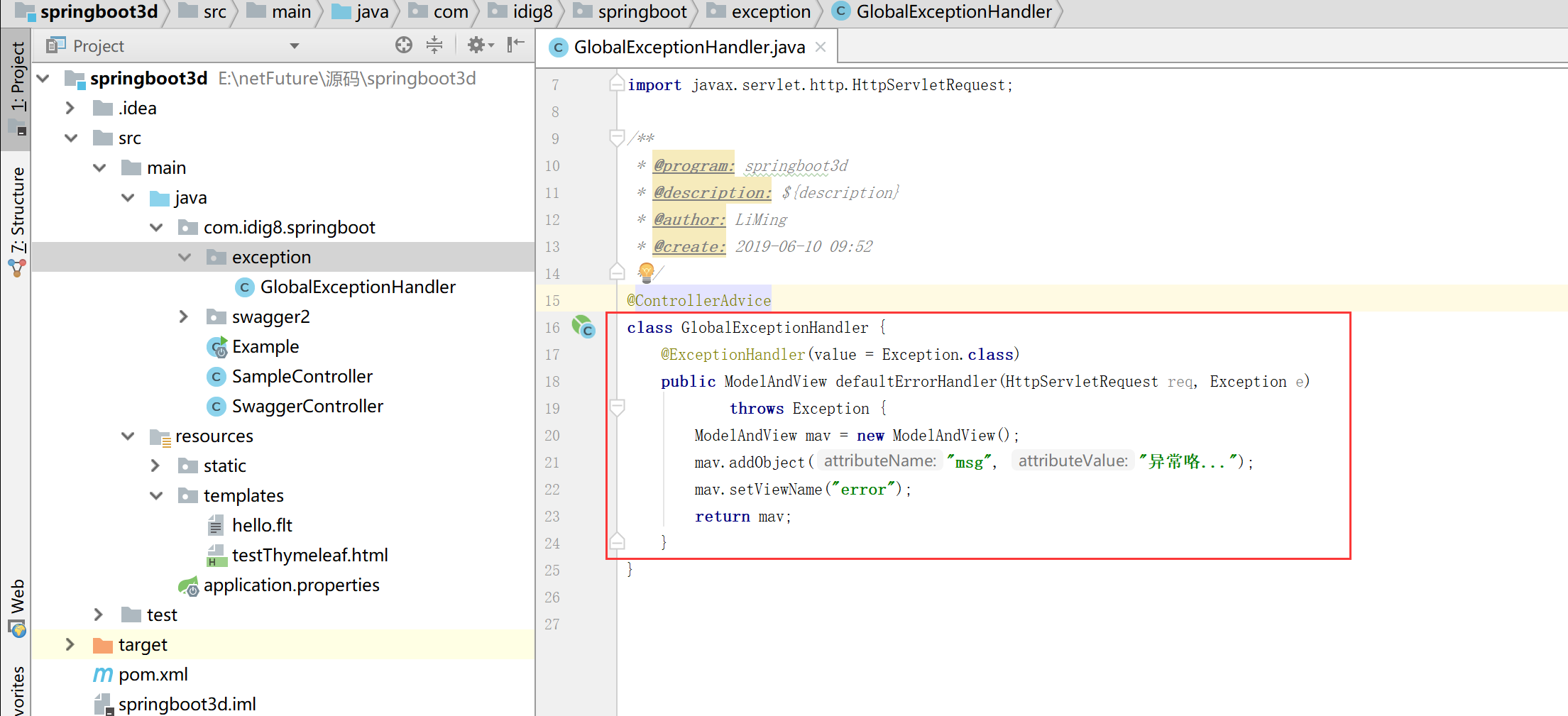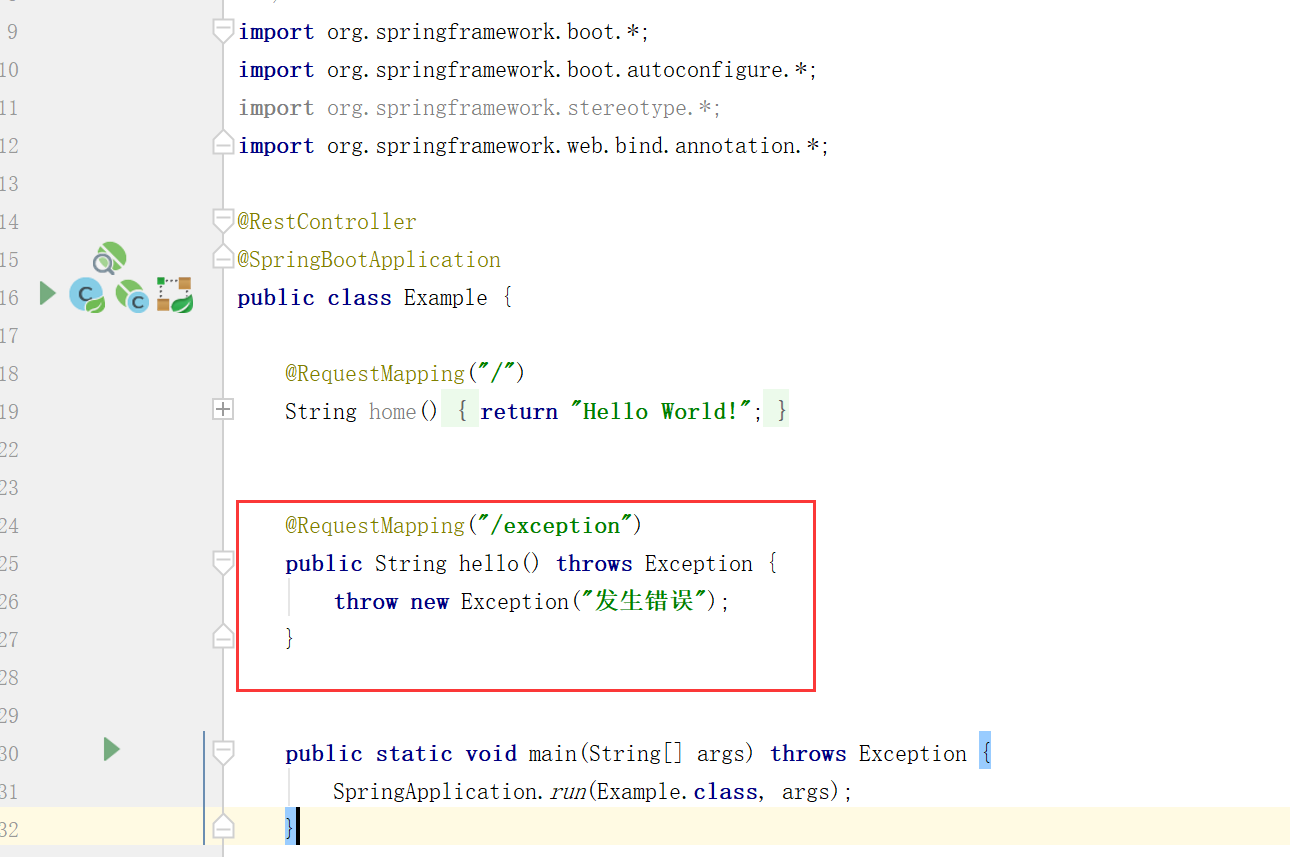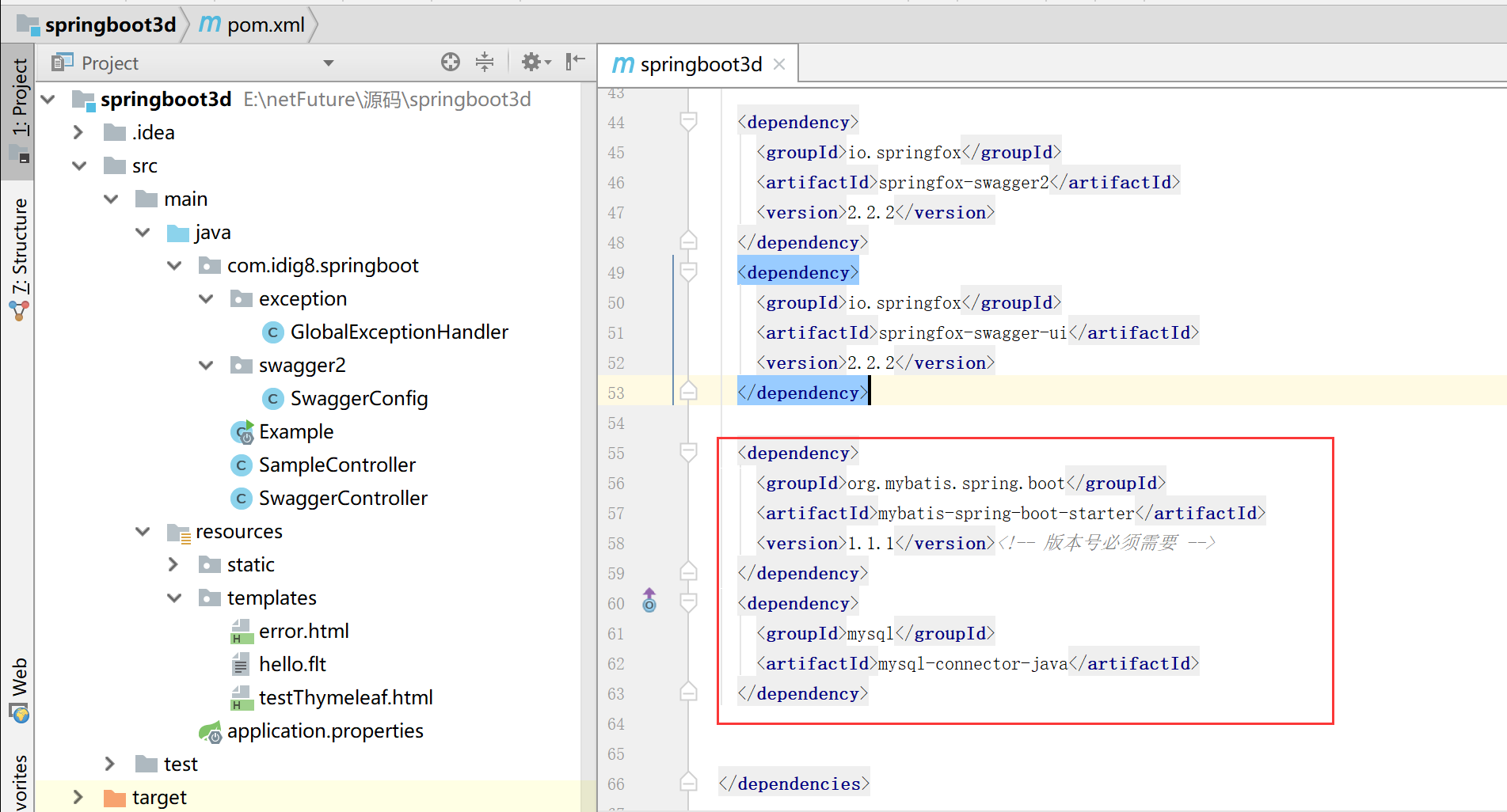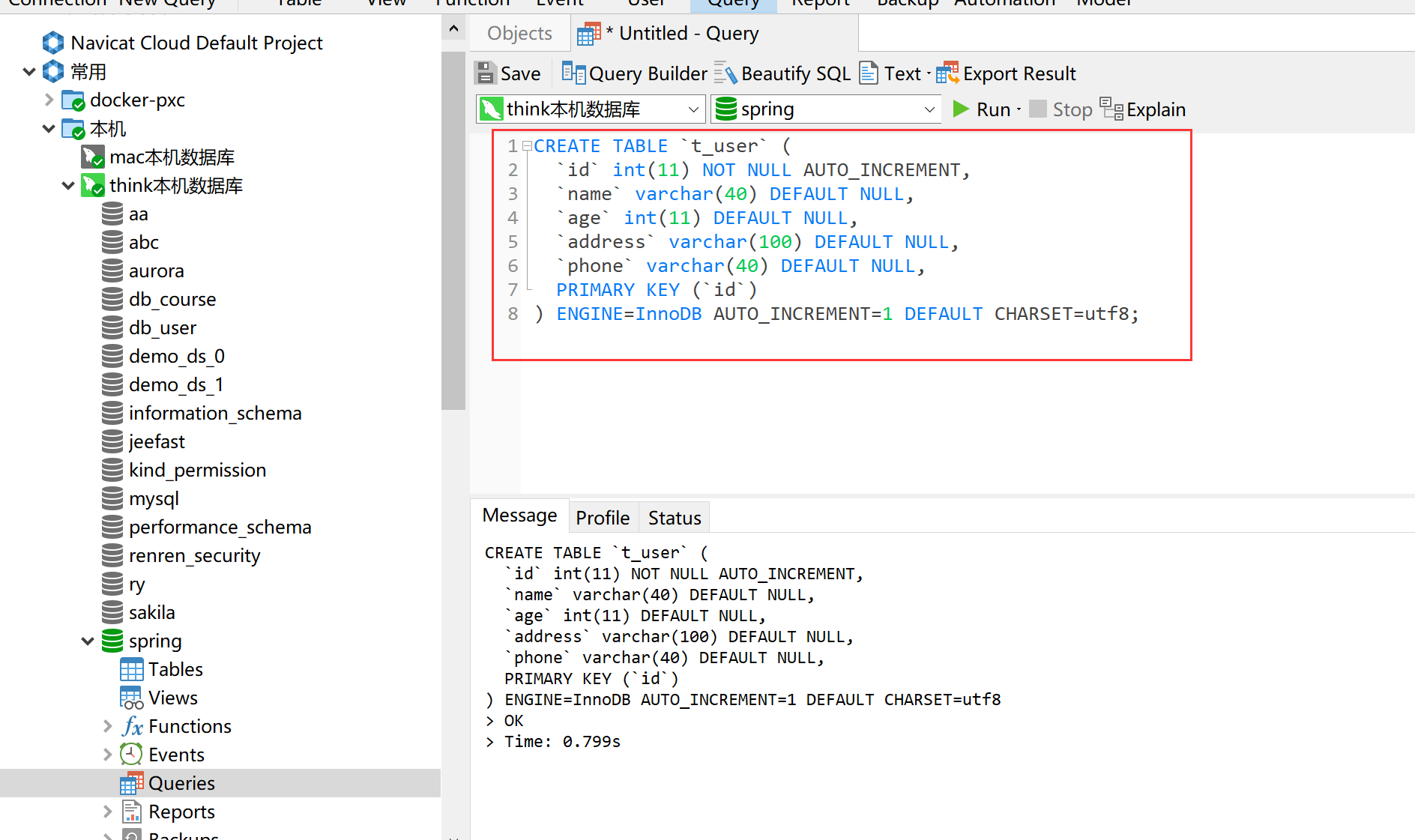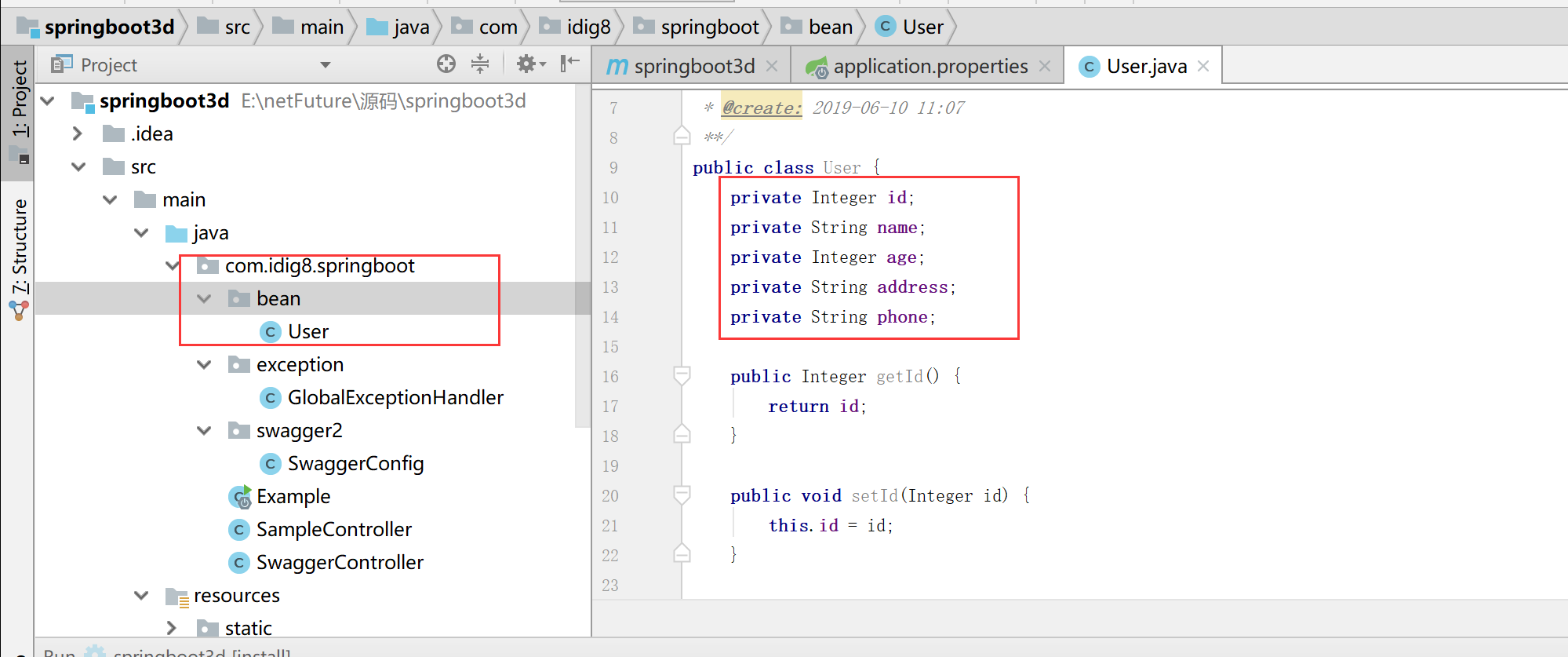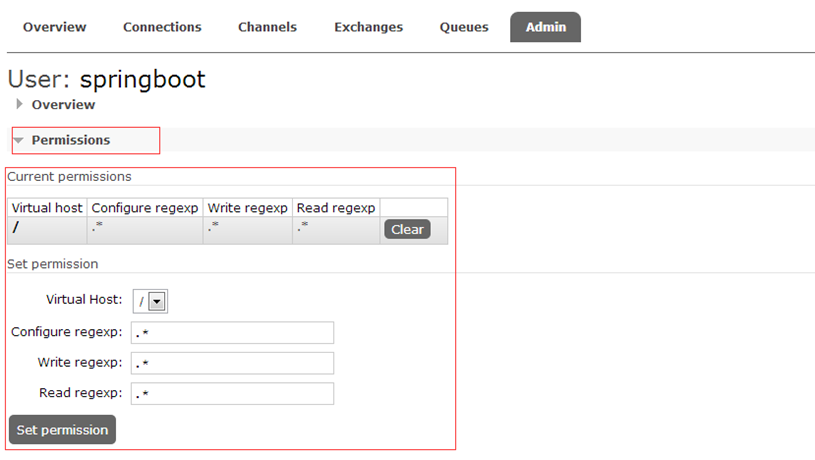继续说集成三方中间件的,主要说说统一异常处理,集成Mybatis,集成redis,集成RabbitMQ。
(一)统一异常处理
创建全局异常处理类:通过使用@ControllerAdvice定义统一的异常处理类,@ExceptionHandler用来定义针对的异常类型。
1.创建统一异常Controller
@ControllerAdvice
class GlobalExceptionHandler {
@ExceptionHandler(value = Exception.class)
public ModelAndView defaultErrorHandler(HttpServletRequest req, Exception e)
throws Exception {
ModelAndView mav = new ModelAndView();
mav.addObject("msg", "异常咯...");
mav.setViewName("error");
return mav;
}
}
2.增加Controller方法,抛出异常
@RequestMapping("/exception")
public String hello() throws Exception {
throw new Exception("发生错误");
}
3.src/main/resources/templates增加error.html
<!DOCTYPE html>
<html xmlns:th="http://www.w3.org/1999/xhtml">
<head>
<meta charset="UTF-8" />
<title>统一异常处理</title>
</head>
<body>
<h1>Error</h1>
<div th:text="${msg}"></div>
</body>
</html>
(二)集成Mybatis
1.修改pom.xml,增加依赖
<dependency>
<groupId>org.mybatis.spring.boot</groupId>
<artifactId>mybatis-spring-boot-starter</artifactId>
<version>1.1.1</version><!-- 版本号必须需要 -->
</dependency>
<dependency>
<groupId>mysql</groupId>
<artifactId>mysql-connector-java</artifactId>
</dependency>
2.mysql的连接配置
application.properties:
spring.datasource.url=jdbc:mysql://localhost:3306/spring
spring.datasource.username=root
spring.datasource.password=root
spring.datasource.driver-class-name=com.mysql.jdbc.Driver
3.创建表t_user
CREATE TABLE `t_user` (
`id` int(11) NOT NULL AUTO_INCREMENT,
`name` varchar(40) DEFAULT NULL,
`age` int(11) DEFAULT NULL,
`address` varchar(100) DEFAULT NULL,
`phone` varchar(40) DEFAULT NULL,
PRIMARY KEY (`id`)
) ENGINE=InnoDB AUTO_INCREMENT=1 DEFAULT CHARSET=utf8;
4.创建User.java文件
包名为:com.idig8.springboot.bean
package com.idig8.springboot.bean;
/**
* @program: springboot3d
* @description: ${description}
* @author: LiMing
* @create: 2019-06-10 11:07
**/
public class User {
private Integer id;
private String name;
private Integer age;
private String address;
private String phone;
public Integer getId() {
return id;
}
public void setId(Integer id) {
this.id = id;
}
public String getName() {
return name;
}
public void setName(String name) {
this.name = name;
}
public Integer getAge() {
return age;
}
public void setAge(Integer age) {
this.age = age;
}
public String getAddress() {
return address;
}
public void setAddress(String address) {
this.address = address;
}
public String getPhone() {
return phone;
}
public void setPhone(String phone) {
this.phone = phone;
}
}
5.创建UserMapper.java接口文件
包名为:com.idig8.springboot.mybatis
package com.idig8.springboot.mybatis;
import com.idig8.springboot.bean.User;
import org.apache.ibatis.annotations.Insert;
import org.apache.ibatis.annotations.Mapper;
import org.apache.ibatis.annotations.Param;
import org.apache.ibatis.annotations.Select;
/**
* @program: springboot3d
* @description: ${description}
* @author: LiMing
* @create: 2019-06-10 11:09
**/
@Mapper
public interface UserMapper {
/**根据id查询用户*/
@Select("SELECT * FROM T_USER WHERE ID = #{id}")
User findById(@Param("id") String id);
/**新增用户*/
@Insert("INSERT INTO T_USER(NAME, AGE, ADDRESS, PHONE) VALUES(#{name}, #{age}, #{address}, #{phone})")
int insert(@Param("name") String name, @Param("age") Integer age,@Param("address") String address,@Param("phone") String phone);
}
6.测试
@RunWith(SpringJUnit4ClassRunner.class)
@SpringBootTest(classes = Example.class)
public class MybatisTest {
@Autowired
private UserMapper userMapper;
@Test
public void testInsert() throws Exception {
int num = userMapper.insert("zhangsan222", 20,"长沙","13100000000");
TestCase.assertEquals(num,1);
}
@Test
public void testFindById() throws Exception {
User u = userMapper.findById("6");
TestCase.assertNotNull(u);
System.out.println(u.getName());
}
(三)集成Mybatis
1.修改pom.xml,增加依赖
<dependency>
<groupId>org.springframework.boot</groupId>
<artifactId>spring-boot-starter-data-redis</artifactId>
</dependency>
注意:旧版本spring boot中集成的redis starter为:spring-boot-starter-redis
2.redis连接配置
注意:spring.redis.database的配置通常使用0即可,Redis在配置的时候可以设置数据库数量,默认为16,可以理解为数据库的schema。
# REDIS (RedisProperties)
# Redis数据库索引(默认为0)
spring.redis.database=0
# Redis服务器地址
spring.redis.host=127.0.0.1
# Redis服务器连接端口
spring.redis.port=6379
# Redis服务器连接密码(默认为空)
spring.redis.password=
# 连接池最大连接数(使用负值表示没有限制)
spring.redis.pool.max-active=8
# 连接池最大阻塞等待时间(使用负值表示没有限制)
spring.redis.pool.max-wait=-1
# 连接池中的最大空闲连接
spring.redis.pool.max-idle=8
# 连接池中的最小空闲连接
spring.redis.pool.min-idle=0
# 连接超时时间(毫秒)
spring.redis.timeout=0
3.测试redis
注意:redis中存储对象,需要我们自己实现RedisSerializer接口来对传入对象进行序列化和反序列化
@RunWith(SpringJUnit4ClassRunner.class)
@SpringBootTest(classes = SpringBootMain.class)
public class SpringRedisTest {
@Autowired
private RedisTemplate<String,String> redisTemplate;
@Test
public void testRedis() throws Exception {
ValueOperations<String, String> ops = redisTemplate.opsForValue();
ops.set("name", "zhangsan");
String value = ops.get("name");
System.out.println(value);
TestCase.assertEquals("zhangsan", value);
}
}
(四)集成RabbitMQ
RabbitMQ是以AMQP协议实现的一种消息中间件产品,
AMQP是Advanced Message Queuing Protocol的简称,它是一个面向消息中间件的开放式标准应用层协议。
AMQP中定义了以下标准特性:
1.消息方向
2.消息队列
3.消息路由(包括:点到点模式和发布-订阅模式)
4.可靠性
5.安全性
关于AMQP 、RabbitMQ的详细内容不再这里过多介绍,本次课主要讲怎么与Spring boot集成。
- 安装RabbitMQ
windows安装不再说了,都是傻瓜试的。linux可能比较麻烦自行百度吧。
打开浏览器并访问:http://localhost:15672/,并使用默认用户guest登录,密码也为guest,即可进入管理界面
新增管理用户并设置权限
username:springboot
password:123456
切换到springboot用户登陆,在All users中,点击Name为springboot, 进入权限设置页面
在权限设置页面,进入Permissions页面,点击“Set permission"
- Spring Boot整合修改pom.xml,增加依赖支持
<dependency>
<groupId>org.springframework.boot</groupId>
<artifactId>spring-boot-starter-amqp</artifactId>
</dependency>
- rabbit mq连接配置
spring.rabbitmq.host=localhost
spring.rabbitmq.port=5672
spring.rabbitmq.username=springboot
spring.rabbitmq.password=123456
- 创建Rabbit配置类
配置类主要用来配置队列、交换器、路由等高级信息
import org.springframework.amqp.core.Queue;
import org.springframework.context.annotation.Bean;
import org.springframework.context.annotation.Configuration;
@Configuration
public class RabbitConfig {
@Bean
public Queue firstQueue() {
// 创建一个队列,名称为:first
return new Queue("first");
}
}
- 创建消息产生者类
说明:通过注入AmqpTemplate接口的实例来实现消息的发送,AmqpTemplate接口定义了一套针对AMQP协议的基础操作。
@Component
public class Sender {
@Autowired
private AmqpTemplate rabbitTemplate;
public void send() {
rabbitTemplate.convertAndSend("first", "test rabbitmq message !!!");
}
}
- 创建消息消费者
说明:
@RabbitListener注解:定义该类需要监听的队列
@RabbitHandler注解:指定对消息的处理
@Component
@RabbitListener(queues = "first")
public class Receiver {
@RabbitHandler
public void process(String msg) {
System.out.println("receive msg : " + msg);
}
}
- 创建测试类
@RunWith(SpringJUnit4ClassRunner.class)
@SpringBootTest(classes = SpringBootMain.class)
public class RabbitmqTest {
@Autowired
private Sender sender;
@Test
public void testRabbitmq() throws Exception {
sender.send();
}
}
- 启动主程序:SpringBootMain
控制台如果出现以下信息,则说明rabbitmq连接成功
Created new connection: rabbitConnectionFactory#29102d45:0/SimpleConnection@1dcfb5ba [delegate=amqp://springboot@127.0.0.1:5672/, localPort= 55088]
- 运行Junit测试类
控制台输出:
receive msg : test rabbitmq message !!!
集成Rabbit MQ完毕!
PS:mq和redis之前在别的专题都说过多次了,这里就不详细的截图了。下次咱们一起说说 日志方面。
共同学习,写下你的评论
评论加载中...
作者其他优质文章



